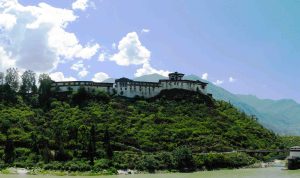Place and Events to Visit Bhutan
Activities
- Archery:
To the Bhutanese, it’s a tourist sport and a very saleable one at that too. It has tremendous tourist appeal. Archery is tradition; it is songs and dances and jeers and near-primitive howls. It is the works to someone seeking the unusual.
All that could be just a facade. Under the surface, and away from the real game, there is plenty afoot. More than a tourist could ever imagine and some locals too. Every time a major archery tournament is on, be it in the village or at the capital, strange things are happening. Perfectly sane, and often well placed men, are doing things that would otherwise have been dubbed completely insane.
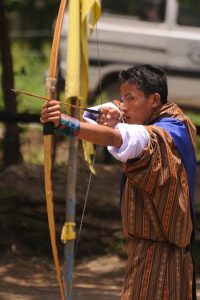
- Rafting:
Generally rafting conjures of images of crashing through horrendous rapids and monstrous waves with laughing and screaming joyful rafters hanging on but in the context of Rafting in Bhutan, it is a gentle drift-down-the-river admiring the scenery and running a few small yet exciting rapids.
The most of the rivers in Bhutan are very steep and highly rushing with limited road access makes it considerably unsuitable for white water rafting. Only a few rivers are opened for rafting considering their safe course and easy access.
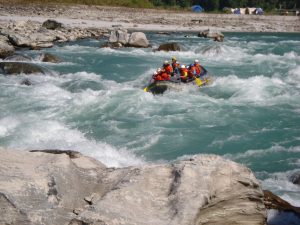
- Mask Dance:
Introduction of Buddhism in the 8th century AD by Guru Padmasambhava from Tibet, ritual and mask dances gained roots in the Bhutanese system as part of the Mahayana Buddhist tradition. With the birth of the great Terton (treasure revealer) Pema Lingpa in the 15th century, the mask dances in Bhutan took firm roots and gained an impetus as part of the Bhutanese cultural life. The Ter Cham (treasure dances) and Pe Ling Ging Sum were the most famous of the dances that still continues to this day. In the 17th century with the arrival of Zhabdrung Ngawang Namgyal from Tibet, the mask dances further gained importance. Many new dances were introduced. The Puna Domchoe was introduced in Punakha Dzong as accompaniment to the prayers to the protector deity Pel yeshey Gonpo (Mahakala). Je Kuenga Gyeltshen, the reincarnation of Jampel Dorji also introduced a dance in honour of Pelden Lhamo (mahakali) in Trashichhodzong. Some of the celebrated dances are Zhana cham or the Black Hat dance, the Degyed cham or the Spirit dance, the Shinje cham or the Yamaraja dance, the Durdag cham or the Dance of Shamashan Lord and the Guru Tshengyed or the Dance of the Eight manifestations of Guru Padmasambhava.
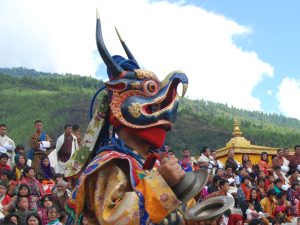
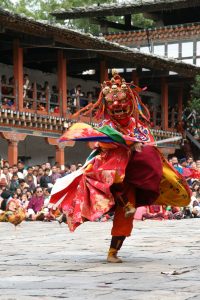
Places
- Bumthang
Population: 16,116 [2005]
Altitude: 2700m
This beautiful valley encapsulates a rich culture, Sceni beauty and hundreds of mythis and legends. People often call “Mine Switzerland”. The drive from Trongsa to Jakar may only take about two hours but the change in scenery is dramatic.
It is the straightest section of the entire length of the road from Paro in the West to Trashigang in the East – a distance of about 610 Kilometres.
The hills around Jakar are filled with monasteries dedicated to Padmasambhava who Is said to have cured an ailing ruler and introduced Buddhism to the valley. Bumthang is also home to one of the great Buddhist teachers, Pemalingpa, to whose descendants the present dynasty traces Its origins. Jambay Lhakang and Jakar Tshechu are host to one of the most spectacular festivals in October each year when on one evening of the festival, the monastery is lit by a fire dance to bless infertile women with children.
Places of Interest
Jakar Dzong, ‘The Fortress of the White Bird’ – It was initially built as a monastery in 1549. The Dzong is now used as administrative center for Bumthang Valley and houses the regional monk body.
Jambay Lhakhang – It is sacred monastery built in the 7th century by the Tibetan King, Songtsen Gampo.
Kurjey Lhakhang – This is another sacred monastery which comprises three temples. These three temples are surrounded by a wall owith 108 choetens.
Tamshing Lhakhang – This Lhakhang is located opposite Kurjey Lhakhang on the other side of the river, it was founded in 1501 by Terton Pema Lingpa. The temple was restored at the end of the 19thcentury.
Mebar Tsho – or the burning lake is one of Bhutan’s sacred pilgrimage sites where sacred scriptures hidden by Guru Padmasambhava in 8th century was recovered by Terton Pema Lingpa in 15thcentury.
Tangbi Goenpa – This Goenpa is half hour walk north of Kurjey Lhakhang. It eas founded in 1470 by Shamar Rinpoche of the Kagyu religious school.
Ura Valley – This valley is believed to be the earlist inhabited place in Bhutan. The road to Ura climbs to an amazingly open countryside.
Ngang Lhakhang – This Lhakhang is located 100m above the valley floor. It was built in 15thcentury by Lama Namkha Samdup. A three-day festival with masked dances is held here each winter to honour the founder of the Lhakhang.
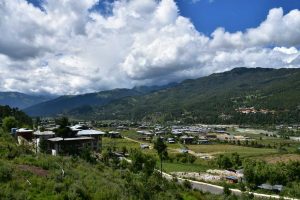
- Mongar
Population: 13,069 [2005]
Altitude: 1620m
The differences between East and West Bhutan are far greater than the high pass that separates them. Perhaps like the Scots and the English, there are subtle but marked differences. History has played a significant role with the kingdom only being unified with the East at the end of the last century and prior to that many wars separated each side. The Eastern dialect is so different from the Western dialect that the two groups find it difficult to understand each other.
Thrumsingla pass and a seven-hour drive separate Ura from Mongar in the East. The journey is one of the most beautiful in all the Himalayas. Rising out of Ura, the highway climbs steeply to the highest pass (3,800 meters) along the West to East highway at Thrumsingla (during the Winter the pass can be closed for several days due to heavy snowfalls) where the mountains of East Bhutan can be seen during clear weather. The descent from Thrumsingla to Lingmithang is astonishing for several reasons. The road drops from 3,800 meters to 650 meters in only a few hours passing from pine forest through semi-tropical forest to orange groves. Carved out of the side of the mountain, in parts the road’s edge borders a sheer cliff which descends several hundred meters vertically with nothing to stop the fall.
Arriving at Mongar marks the beginning of your Eastern Bhutan experience. Towns in Eastern Bhutan are built on the sides of the hills contrary to the West where they develop on the valley floor. Mongar Dzong was built in 1953 on the orders of the Third King, Jigme Dorje Wangchuck. The BTCL guesthouse is located near the Dzong enjoying a pleasant view from the garden over the Mongar Valley.
Places of Interest in Mongar
Mongar Dzong – This is one of the Bhutan’s newest Dzong, built in 1930s.
Yakgang Lhakhang – This is a privetly owened monastry founded by Lama Sangdag the 6th son of Terton Pema Lingpa.
Drametse Lhakhang – This Lhakhang is located in between the Trashigang to Mongar highway. It is one of the most important monastry in eastern Bhutan.
Zhongar Dzong – It has remained in ruins for centuries is briefly visible from the Mongar-Bumthang highway.
Tagchu Goenpa – This is also another privetly owned Lhakhang built in 1825 by one of the disciples of Togden Shakya Shri, a renowned lama from eastern Tibet.
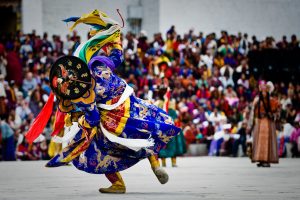
- Paro Valley
Population: 36,433 (2005)
Altitude: 2280m
Normally, Paro is both entry and Exit point of Bhutan there can be few more charming valleys to be welcomed by, or from which to remember the land of the Thunder Dragon. As you climb down from the aircraft and take your first breath of Bhutanese air, you will be struck by the silence and peace of Paro’s valley. A destination all of its own, Paro is home to the national museum and watchtower to one of the oldest and most celebrated Dzong in all Bhutan. At 7382 ft Paro is the site of Bhutan’s only airport and is the most beautiful western valley.
Paro Town is small but one of the most beautiful town in Bhutan. This beautiful valley is home to many of Bhutan oldest monasteries and temples. Mount Chomolhari (7300m) reigns in white glory at the northern end of the valley whose glacier water forms the Pachu flowing through the valleys.
Apart from commanding a slightly elevated strategic point overlooking the longest stretch of the Paro Valley, Paro Dzong is symbolic as the religious and secular centre of all affairs of the valley. It Is also an architectural wonder, setting the tone for official Dzong. Throughout the kingdom and inviting the visitor to wonder at the cultural strength of the kingdom’s heritage. The dzong itself was conceived in the 15th century and finally consecrated In 1646. Above the dzong is the old watchtower which is now home to Bhutan’s national museum. The museum’s collection includes ancient Bhutanese arts and artifacts, weapons and stamps, birds and animals. This is typical of the eclectic beauty of Bhutan – its prized objects bear little relation to each other but as a whole stand together as a history of one of the world’s most pristine people.
It is said that Guru Rinpoche, the father of the Bhutanese strain of Mahavana Buddhism, arrived in the Paro Valley more than a arrived in the Paid Valley more than a millennium ago on the back of a legendary tigress. He meditated for three months in a cave where a monastery was later built and called Taktsang Lhakang or Tiger’s Nest. Visitors to Paro can take a closer look at the monastery by ascending either on foot or by pony for about three hours to Tiger’s Nest. Walkers can enjoy a well-earned rest at a BTCL coffeehouse situated at a wonderful vantage point of the monastery.
Places of interest in Paro
Rinpung Dzong – Rinpung means “Fortress on a Heap of Jewels”. It was built in 1646 AD by Zhabdrung Ngawang Namgyal. A walk through the bridge to the Dzong, over a stone inlaid path, offers a good view of the Dzong.
Ta Dzong – Built in 1951, was once the watch tower for the defence of Rinpung Dzong during inter-valley wars of the 17th century. The visit to the Ta Dzong will provide an insight into the rich and unique cultural heritage and tradition of Bhutan.
Drugyal Dzong – Drugyal means “Victorious”. It was built in 1646 by Zhsbdrung Ngawang Namgyal to commemorate his victory over Tibetan invaders, led by the Mongolian warlord.
Kyichu Lhakhang – It is one of the oldest and most sacred temple in the Kingdom of Bhutan, dating back to the 7th century.
Kila Goenpa – It is a peaceful home for Buddhist nuns who have dedicated their life to spiritual fulfillment and lead undisturbed lives of religious studies, prayer and meditation.
Druk Choeding Lhakhang – It is also known Tshongdoe Naktsang, it is the town temple. This temple was built in 1525 by Zhabdrung Chhogyel.
Dungtse Lhakhang – This Lhakhang was built in 1433 by the iron bridge builder Thangton Gyalpo.
Taktsang Monastery – Popularly known as the Tiger’s Nest. It is Bhutan’ most venerated temple. It is located on the side of a 900m cliff above the Paro valley.
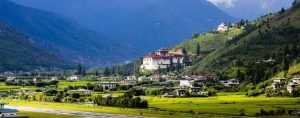
- Phuntsholing (Gate way for Trading and entry with India)
Altitude: 300m
This small modern town in the south is the gateway of Bhutan for overland travellers. Like all other border towns, it is only a prelude. Phuntsholing is fascinating mixture of Bhutanese and Indian, a lively centre for the mingling people, languages, costumes and goods. On top of a low hill at nearby Kharbandi, a small Gompa situated in a garden of tropical plants and flowers, overlooks the town and surrounding plains.
The Amo Chu, commonly is known as the Torsa river flows alongside this town and it is favorite spot for fisherman and picnickers. From Phuntsholing, the road winds north, over the southern foothills, through lush forested valleys and around the rugged north- south ridges of the inner Himalaya to the central valleys of Thimphu and Paro. It is a scenic journey; forests festooned with orchids cover the mountains on either side and exciting hairpin curves greet travelers with colorful sculptures of Tashi Tagye (the eight suspicious sign of Buddhism).
Places of Interest in Phuntsholing
Kharbandi Goenpa – It is a beautiful monastery situated at an altitude of 380m. It was founded in 1967 by the Late Royal Grand Mother, Ashi Phuntsho Choden.
Zangto Pelri – It is a small temple modelled like Zangto Pelri, meaning “copper-coloured mountain” situated in the centre of the town.
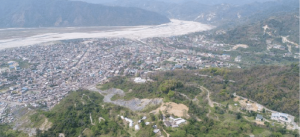
- Punakha (old capital city)
Pupulation: 17715 (2005)
Altitude: 1220m
The first stop after leaving Thimphu on the journey East is Dochula Pass at 10500 feet. Only 45 minutes from Thimphu, it offers visitors their outstanding view of the Himalayan range. The best time to reach Dochula Is dawn when the clouds are thin and the rhododendron are in season. Then the early morning sun casts breathtaking light on the distant mountains framed in shades of red from the brilliant flowers. The road to Punakha branches off left and curls its way down the valley to the relative lowlands of the Punakha Valley. The town of Punakha does not hold many attractions apart from the glorious dzong which dominates the valley floor. Before Thimphu was made capital of Bhutan, Punakha held the title as Winter capital because of its more temperate climate. Thimphu’s monk body and the Je Khenpo (leader of Bhutan’s religious order) still come to Punakha to pass the winter. Punakha Dzong was strategically built at the confluence of the Phochu (male) and Mochu (female) rivers by the first Shabdrung of Bhutan, Ngawang Namgyel in 1637. It has been destroyed by four fires and an earthquake in 1897 and has frequently been devastated by flood water coming from the great northern glaciers. The Dzong has now been fully restored to its original splendor.
Places of interest in Punakha
Punakha Dzong – This Dzong is also known as “Palace of Happiness”. It is a massive structure at the junction of two rivers.
Khamsum Yulley Namgyel Choeten – It is located at an hour hike from the road side. It was built to chase out the negative forces and promote peace.
Chimi Lhakhang – The temple was built in 1499 and is located on a hillock on the centre of the valley. It is dedicated to Lama Drukpa Kunley. It is widely believed that childless couples who pray at this temple are usually blessed with children.
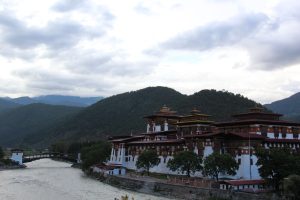
- Trashigang
Population: 51134 [2005]
Altitude: 1620m
Trashigang is the Easternmost point on the highway. Eastern residents use Trashigang to trade and the town itself is usually a hive of activity – especially around the bus station where buses are frequently leaving for Thimphu and Paro in the West and Samdrup Jonkhar and India, only a few hours to the South. Trashigang is also a melting pot of hill tribe people who come in to the town to trade. In particular, the unusual Merak and Sakteng people come to Trashigang to trade yak’s butter for the provisions that they need in the mountains. Merak and Sakteng are located about 50 miles East of Trashigang close to the border with India’s Arunachal Pradesh. Trashigang Dzong sits on a jagged piece of land jutting out from the town and is the first land- mark that can be seen from the road winding up to Trashigang. The Dzong was built in 1659 and commands a spectacular view over the valley for which it is the administrative centre. The Dzong is significant for the fact that it only has one courtyard.
Places of Interest in Trashigang
Trashigang Dzong – It is also called as “Dzong of Auspicious Mount”. It is situated on a very steep hill overlooking the river, Drangme Chhu. It was built in 1659 by Kudung Pekar Chopel.
Ranjung Woesel Chholing – This monastry is more than half an hour drive from Trashigang town. This monastry was founded by Garab Rinpoche in 1990.
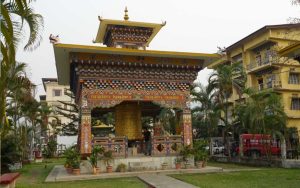
- Takshang Monestery:
Takshang, literally meaning Tiger’s Nest, built around a cave in which Guru Rimpoche (Padmasambava ) meditated, clings seemingly impossible to a cliff of rock at 3,000 feet (800m.) above the valley floor. For local people it is a place of pilgrimage, but for a tourist, a hike to the viewpoint opposite the monastery in exhausting, thrilling and mystical.
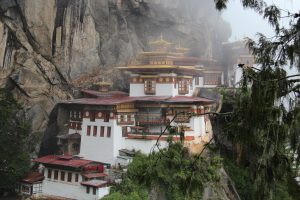
- Thimphu (capital city)
Population: 98676
Altitude: 2320m (2005)
Thimphu is a small, charming capital city sandwiched in the heart of the Himalayas. It sits in its own valley fanning out from the river. The skyline hardly changes as new buildings are all constructed under zoning regulations. Thimphu’s development is strictly monitored and buildings cannot exceed a certain height, nor can they be designed in anything but the traditional Bhutanese style.
Only a sprinkling of cars is ever found along the main street and the capital’s population is not immediately visible. But, if you look, inside the bank or the shop, you will find Thimphu’s people and Bhutan’s heart. Dressed in kho and kira, Thimphu people go about their work methodically, quietly bringing their nation through the growing pains of development and into its own definition of the modem world. Sirntokha Dzong, six kms from the city limits is the kingdom’s oldest dzong which is now used as the Dzongka language school of Bhutan. Bhutan’s most stately and arguably most impressive building is Tashicchodzong, on the banks of the Wangchu (Thimphu River).
The home of the National Assembly and the summer residence of the capital’s venerated monastic community, Tashichodzong is a palatial building overlooking the river on the South side and the city of Thimphu from the North. While foreign visitors are only allowed to enter Tashicchodzong during the annual festival, Its presence and its exterior and grounds provide a delightful spectacle. The dzong is the impressive result of a redesign of the original rnedieval structure sanctioned by the Third King, HM Jigme Dorje Wangchuck, when he moved Bhutan’s permanent capital to Thimphu.
The most enjoyable way of passing time in Thimphu is just to wander along its main street. Many of the items on sale are made In India but textiles and the wooden crafts are Bhutanese as are all of the religious products. Thimphu’s weekend market is another chance to watch the way life goes in the kingdom. Here, every weekend, Thimphu’s residents break from whatever it Is that they are doing to come to the market to pick up their weekly stock of vegetables, a copy of Kuensel (the weekly newspaper) and to exchange the week’s gossip. It is a custom as old as the market and one both buyer and seller enjoy. For visitors who can’t share In the gossip, a wander through the stalls reveals mountains of bright red chillies, eggplants and okra, asparagus In season and rice of every size. Traditional Bhutanese masks are sold, as are the carpets more reasonably found in Trongsa. On sale every weekend at no cost Is life in Bhutan, a product to be cherished.
Another of Bhutan’s loveliest exports is its wide and multifarious collection of stamps. These are best seen in commemorative books inside Thimphu’s central post office. Other places of Interest in Thimphu include the traditional painting school where the age-old styles of Bhutanese painting, including thangka painting, are taught and the Memorial Chorten built in memory of His Majesty, the Third King of Bhutan. The National Library houses a vast collection of books and research documents of Buddhist studies.
Places of interest in Thimphu
Tashichhodzong – Also known as the “Fortress of the Glorious Religion”. It was built in 1641. The Dzong was later rebuilt by the third king, His Majesty Jigme Dorji Wangchuk in 1965.
The National Textile Museum – This museum displays a range of beautiful Bhutanese textiles. It was started in 2001, under the patronage of Her Majesty the Queen, Ashi Sangay Choden Wangchuk.
The Folk Heritage Museum – It is also known as Phelchey Toenkhim, It provides a fascinating insight into the traditional Bhutanese farm house and rural past through exhibits and documentation of rural life.
The National Institute for Zorig Chusum – Is also known as the School of Arts and Crafts. It is an institute where students undertake a six-year course on the 13 traditional arts and crafts of Bhutan.
The Institute of Traditional Medicine Services – Here Bhutan’s famous traditional medicine are compounded and dispensed.
Takin Preserve – Here you will find the rare national animal of Bhutan. The best time to see them is early morning. The Takin is listed by international conservation agencies as the animal found only in Bhutan, Nepal, Burma and China.
The National Library – This library holds a vast collection of Bhuddhist texts and manuscripts, some dating back several hundred years, as well as modern academic books mainly on Himalayan culture and religion.
The National Memorial Choeten – It is a sacred shrine built in 1974 in the memory of the “Father of Modern Bhutan”, third Druk Gyalpo Jigme Dorji Wangchuk.
Dechenphodrang – This is a monastic school with more than 450 monks currently undergoing their studies.
Changangkha Lhakhang – This is an old fortress-like temple perched on a ridge above Thimphu. The temple was built in 12th century by Lama Phajo Drugom Shigpo’s son Nyima.
Zangto Pelri Lhakhang – This is a private temple built in 1990s by Late Dasho Aku Tongmi, a musician who composed Bhutan’s national anthem.
Semtokha Dzong – It stands on a lofty ridge five miles from Thimphu town was built in 1627 by Zhabdrung Ngawang Namgyal.
Phajoding Goenpa – It is a three hours walk from upper Thimphu. The monastery was built in the 15th century by Shagcha Rinchen who introduced the Drukpa Kagyu School in Bhutan in the 13thcentury.
Tango Goenpa – It is a half hour drive from Thimphu town and an hour walk to the monastery.
Cheri Goenpa – It is a half hour drive from Thimphu town and an hour walk to the monastery. The trail starts from a quaint bridge that spans the Thimphu Chhu.
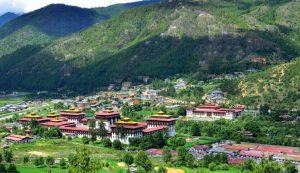
- Trashigang
Population: 51134 [2005]
Altitude: 1620m
Trashigang is the Easternmost point on the highway. Eastern residents use Trashigang to trade and the town itself is usually a hive of activity – especially around the bus station where buses are frequently leaving for Thimphu and Paro in the West and Samdrup Jonkhar and India, only a few hours to the South. Trashigang is also a melting pot of hill tribe people who come in to the town to trade. In particular, the unusual Merak and Sakteng people come to Trashigang to trade yak’s butter for the provisions that they need in the mountains. Merak and Sakteng are located about 50 miles East of Trashigang close to the border with India’s Arunachal Pradesh. Trashigang Dzong sits on a jagged piece of land jutting out from the town and is the first land- mark that can be seen from the road winding up to Trashigang. The Dzong was built in 1659 and commands a spectacular view over the valley for which it is the administrative centre. The Dzong is significant for the fact that it only has one courtyard.
Places of Interest in Trashigang
Trashigang Dzong – It is also called as “Dzong of Auspicious Mount”. It is situated on a very steep hill overlooking the river, Drangme Chhu. It was built in 1659 by Kudung Pekar Chopel.
Ranjung Woesel Chholing – This monastry is more than half an hour drive from Trashigang town. This monastry was founded by Garab Rinpoche in 1990.
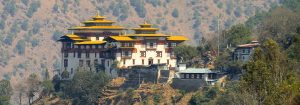
- Trashiyangtse
Population: 39961 [2005]
Altitude: 160m
The village of Doksum is a few kilometers past Gom Kora, a small temple on the side of the road. A large boulder sits In the garden of Gom Kora and it is said that if anyone can climb below the rock and emerge from its summit, he will be forgiven of his sins. Doksum is a weaver’s village where the women sit in fair weather on balconies with wooden slats strapped to their backs rocking back and forth to the rhythm of their looms. Tashiyangtse is a small village with a garden aspect and a lovely place from where to launch a couple of hour’s stroll into the surrounding countryside. Chorten Kora is one of the only two such stupas in Bhutan with styles similar. To those found in Nepal and is host to a great festival every March which attracts all of East Bhutan’s residents. The Chorten is entirely whitewashed and ideally situated next to a running brook.
Places of interest in Trashiyangtse
Trashiyangtse Dzong – This Dzong was re-built in 1656 by Terton Pema Lingpa from the ruins of Dongdi Dzong of 9th century.
Choeten Kora – It is patterned on the stupa of Boudhanat in Kathmandu, Nepal. It was built in 1740 by Lama Ngawang Loday.
Bomdeling Wildlife Sanctuary – It is a winter roosting place for the Black-necked Crane. It is also a home to Snow Leopards, tigers and Red Pandas.
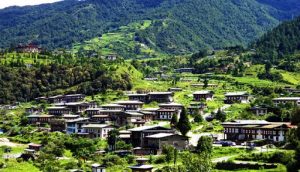
- Trongsa
Population: 13419 [2005]
Altitude: 2000m
Ancestral home of Bhutan’s ruling dynasty and site of Bhutan’s most impressive fortress, Trongsa is a strategically located town on the east-west route. Sloping down the contour of a ridge stands the many-leveled Trongsa Dzong, built In 1648. The Dzong acts as a defensive fortress, stepping down into the valley and its bright golden yellow roof occupies most of the view from Trongsa. The Crown Prince of Bhutan traditionally becomes Penlop or Governor of Trongsa before being crowned King.
Trongsa Dzong was built in 1648 and has been the traditional home of all four kings of Bhutan prior to their ascending the throne. Trongsa’s location in the geographic centre of the kingdom has enabled a Penlop to effectively control the entire East and West of the country from there.
Ta Dzong, or the watch tower which once guarded the Dzong from internal rebellion, stands impressively above the Dzong and provides a visitor with more insight into the historical significance of Trongsa in Bhutan’s history.
Places of interest in Trongsa
Trongsa Dzong – Also known as “Fortress on tip of a Conch”. This is the longest Dzong in Bhutan. The Dzong was originally built in 1648 by Zhabdrung Ngawang Namgyal.
Ta Dzong – The Watch Tower. This was once the guard of the Trongsa Dzong from internal rebellion.
Chendebji Choeten – Situated at the confluence of two rivers on the way to Trongsa. This choeten is a replica of the Boudhanath temple in Kathmandu, Nepal with eyes painted at the four cardinal points.
Kuenga Rabten – The winter palace of the second king, His Majesty Jigme Wangchuk. Located about an hour drive from Trongsa town.
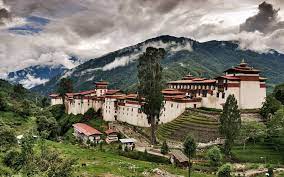
- Wanddue Phodrang
Population: 31135 [2005]
Altitude: 1240m
A 30-minute drive from Punakha is Wangduephodrang. It’s more familiarly known as Wangdue. At 4300 ft Wangduephodrang is distinguished primarily by its Dzong, which completely covers the spur of a hill and commands excellent views of both the east-west and north-south routes. A bustling market with well-stocked shops and a pretty view over its own valley and Dzong. Wangdue is a good place to stretch your legs and wander around the shops before heading East.
Places of interest in Wangdue Phodrang
Wangdue Phodrang Dzong – This Dzong was founded by Zhabdrung Ngawang Namgyal in 1638. It is located on top of a high ridge overlooking a river junction.
Phobjikha Valley – This is the winter home of the rare Black-necked Crane, an endangered species that migrates from its northern habitats in Tibet and Siberia, each winter.
Gangtey Goenpa – Gangtey Goenpa is a major attraction with an ol monastery dating back to the 16th century.
